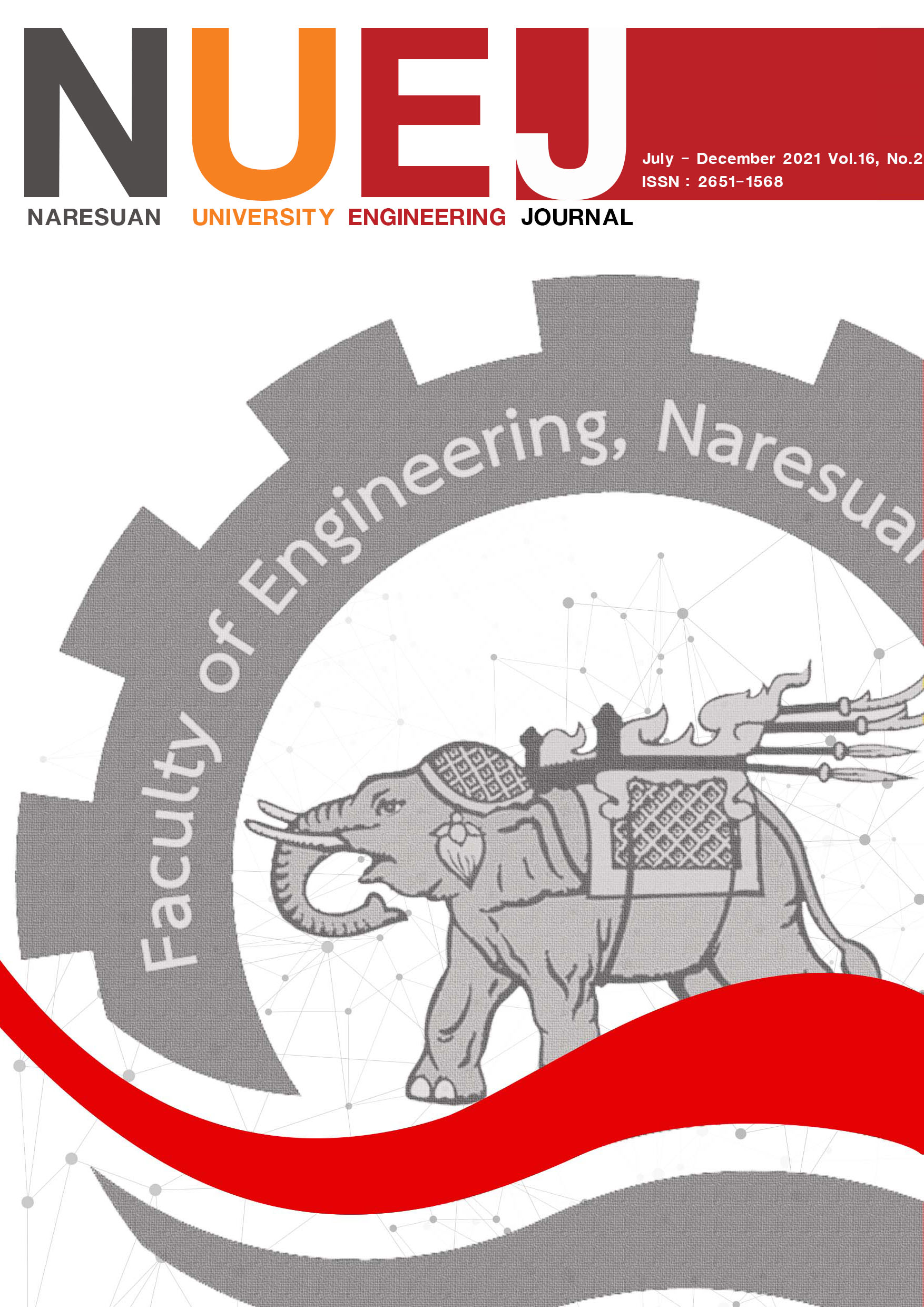Effects of Aeration and Quantity of Effective Microorganisms (EM) Balls for Water Quality Restoration
Main Article Content
Abstract
The simple and low cost water treatment of effective microorganisms (EM) technology was applied to remove NH4-N and carbon content via EM balls, which were prepared from EM stock, molasses and dried bran. The opened reactors were operated under different air supplies (namely no aeration and aeration reactors) and number of EM balls (namely 1EM, 2EM and 3EM reactors). The results revealed that the use of EM balls caused the immediately reduction of NH4-N and COD from active microorganisms activity. However, the decomposition of substrates contents in EM balls led to the increasing NH4-N and COD concentrations, and both pollutants were again decreased consequently. The aeration reactor achieved the greater pollutants removal (83% for total nitrogen and 80% for COD) as well as the greater NH4-N reduction rate (8.8 mg/L-day) rather than the no aeration reactor (77% of total nitrogen, 60% for COD and 2.8 mg/L-day for NH4-N reduction rate) removal. In addition, the aeration reactor also provided the low water turbidity after operating for 17 days. In the meanwhile, the number of EM balls had significant impacts on pollutants removal; the best performance was observed in 2EM reactor, and followed by 1EM reactor and 3EM reactor. This was because the excessive EM balls led to very high NH4-N and COD releasing from substrates decomposition. The optimal number of EM balls and affordable cost from continuous aeration should be concerned for on-site water quality improvement.
Article Details

This work is licensed under a Creative Commons Attribution-NonCommercial-NoDerivatives 4.0 International License.
References
Abd El-Mageed, T. A., Rady, M. M., Taha, R. S., Abd El Azeam, S., Simpson, C. R., & Semida, W. M. (2020). Effects of integrated use of residual sulfur-enhanced biochar with effective microorganisms on soil properties, plant rowth and short-term productivity of Capsicum annuum under salt stress. Scientia Horticulturae, 261, 108930 https://doi.org/https://doi.org/10.1016/j.scienta.2019.108930
Alikhani, J., Takács, I., Al-Omari, A., Murthy, S., & Massoudieh, A. (2017). Evaluation of the information content of long-term wastewater characteristics data in relation to activated sludge model parameters. Water Science and Technology, 75, 1370-1389. https://doi.org/10.2166/wst.2017.004
APHA. (2017). Standard Methods for the Examination of Water and Wastewater. 23rd Edn., American Public Health Association/American Water Works Association/Water Environment Federation, Washington DC, USA.
Boruszko, D. (2017). Research on the influence of anaerobic stabilization of various dairy sewage sludge on biodegradation of polycyclic aromatic hydrocarbons PAHs with the use of effective microorganisms. Environmental Research, 155, 344-352.https://doi.org/https://doi.org/10.1016/j.envres.2017.02.019
Higa, T., & Kanal, A. (1996). An Earth Saving Revolution: A Means to Resolve Our World's Problems Through Effective Microorganisms (EM). Sunmark Pub https://books.google.co.th/books?id=drOMQQAACAAJ
Kamaraj, M., Srinivasan, N. R., Assefa, G., Adugna, A. T., & Kebede, M. (2020). Facile development of sunlit ZnO nanoparticles-activated carbon hybrid from pernicious weed as an operative nano-adsorbent for removal of methylene blue and chromium from aqueous solution: Extended application in tannery industrial wastewater. Environmental Technology & Innovation, 17, 100540 https://doi.org/https://doi.org/10.1016/j.eti.2019.100540
Lananan, F., Abdul Hamid, S. H., Din, W. N. S., Ali, N. a., Khatoon, H., Jusoh, A., & Endut, A. (2014). Symbiotic bioremediation of aquaculture wastewater in reducing ammonia and phosphorus utilizing Effective Microorganism (EM-1) and microalgae (Chlorella sp.). International Biodeterioration & Biodegradation, 95, 127-134 https://doi.org/https://doi.org/10.1016/j.ibiod.2014.06.013
Naddeo, V., Secondes, M. F. N., Borea, L., Hasan, S. W., Ballesteros, F., & Belgiorno, V. (2020). Removal of contaminants of emerging concern from real wastewater by an innovative hybrid membrane process – UltraSound, Adsorption, and Membrane ultrafiltration (USAMe®). Ultrasonics Sonochemistry, 68, 105237. https://doi.org/https://doi.org/10.1016/j.ultsonc h.2020.105237
Namsivayam, S. K. R., Narendrakumar, G., & Kumar, J. (2011). Evaluation of Effective Microorganism
(EM) for treatment of domestic sewage. Journal of Experimental Sciences, 2, 30-32. Pollution Control Department, Ministry of Natural Resources and Environment (2021). https://www.pcd.go.th/.
Priya, M., Meenambal, T., Balasubramanian, N., & Perumal, B. (2015). Comparative Study of Treatment of Sago Wastewater using HUASB Reactor in the Presence and Absence of Effective Microorganisms. Procedia Earth and Planetary Science, 11, 483-490.https://doi.org/https://doi.org/10.1016/j.proeps. 2015.06.048
Rashed, E. M., & Massoud, M. (2015). The effect of effective microorganisms (EM) on EBPR in modified contact stabilization system. HBRC Journal, 11(3), 384-392 https://doi.org/https://doi.org/10.1016/j.hbrcj.2014.06.011
Song, J., Zhang, W., Gao, J., Hu, X., Zhang, C., He, Q., Yang, F., Wang, H., Wang, X., & Zhan, X.
(2020). A pilot-scale study on the treatment of landfill leachate by a composite biological
system under low dissolved oxygen conditions:Performance and microbial community.
Bioresource Technology, 296, 122344.https://doi.org/https://doi.org/10.1016/j.biortech.2019.122344
Tenore, A., Vieira, J., Frunzo, L., Luongo, V., & Fabbricino, M. (2020). Calibration and validation of an activated sludge model for membrane bioreactor wastewater treatment plants. Environmental Technology, 41(15), 1923-1936. https://doi.org/10.1080/09593330.2018.1551940
Thepnarong K., Chiayvareesajja S., Kantachote D. (2015). Efficiency of fermented organic matter and effective microorganism (EM) ball for treating effluent from freshwater aquaculture. Thaksin Journal, 18(1), 15-22.
Victoria, J., & Mahaeswari, U. N. (2016). Effective microorganisms – An incredible alternative for wastewater treatment. International Journal of Development Research, 6, 9399-9403


